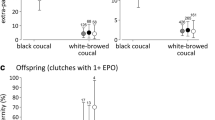Abstract
Despite mounting evidence that extra-pair copulations (EPCs) are common in the Canidae, no studies have examined the most basal member of this family, the gray fox (Urocyon cinereoargenteus). In this study we explored the possibility that gray foxes may be socially, but not genetically, monogamous. Multiple paternity was confirmed in one litter and suspected in three others (n =7), thus 14.3–57.1% of all litters had more than one father. In this high-density population, multiple paternity may be one strategy to reduce inbreeding, although only one pair was significantly related to each other (r =0.36). Mother-daughter pairs were more common than father-son pairs. These results coupled with a previous study showing a female-biased sex ratio suggest male-biased dispersal and the potential for helper females.
Similar content being viewed by others
References
Baker, P.J., Funk, S.M., Bruford, M.W., Harris, S. 2004. Polygynandry in a red fox population: implications for the evolution of group living in canids? Behav. Ecol. 15, 766–778.
Bisbal, F.G. 1982. Nuevos registros de distribution para el zorro gris Urocyon cinereoargenteus venezuelae. Acta Cient. Venez. 33, 255–257.
Boutin-Ganache, I., Raposo, M., Raymond, M., Deschepper, C.F. 2001. M13-tailed primers improve the readability and usability of microsatellite analyses performed with two different allele-sizing methods. BioTechniques 31, 24–28.
Chamberlain, M.J., Leopold, B.D. 2000. Spatial use patterns, seasonal habitat selection, and interactions among adult gray foxes in Mississippi. J. Wildl. Manage. 64, 742–751.
Cothran, E.G., Smith, M.H., Wolff, J.O., Gentry J.B. 1991. Mammals of the Savannah River Site. SRO-NERP-21, Aiken, SC.
Cumbie, P.M., Jenkins, J.H. 1975. Mercury accumulation in native mammals of the southeast. In: Proceedings of the Twenty-Eighth Annual Conference of the Southeastern Association of Game and Fish Commissioners, White Sulphur Springs, West Virginia, pp. 639–648.
DeWoody, J.A., Schupp, J., Kenefic, L., Busch, J., Murfitt, L., Keim, P. 2004. Universal method for producing ROX-labeled size standards suitable for automated genotyping. BioTechniques 37, 348–352.
Follmann, E.H. 1973. Comparative ecology and behavior of red and gray foxes. Ph.D. Dissertation, Southern Illinois University, Carbondale.
Fritzell, E.K., Haroldson, K.J. 1982. Urocyon cinereoargenteus. Mamm. Species 189, 1–8.
Fuller, T.K. 1978. Variable home-range sizes of female gray foxes. J. Mammal. 59, 446–449.
Gaines, K.F., Lord, C.G., Boring, C.S., Brisbin Jr., I.L., Gochfeld, M., Burger, J. 2000. Raccoons as potential vectors of radionuclide contamination to human food chains from a nuclear industrial site. J. Wildl. Manage. 64, 199–208.
Geffen, E., Gompper, M.E., Gittleman, J.L., Luh, H.K., Macdonald, D.W., Wayne, R.K. 1996. Size, life-history traits, and social organization in the canidae: reevaluation. Am. Nat. 147, 140–160.
Gittleman, J.L. 1989. Carnivore group living; comparative trends. In: Gittleman, J.L. (Ed.), Carnivore Behavior, Ecology, and Evolution, vol. 1. Cornell University Press, Ithaca, NY, pp. 183–207.
Goodnight, K.F., Queller, D.C. 1999. Computer software for performing likelihood tests of pedigree relationship using genetic markers. Mol. Ecol. 8, 1231–1234.
Jenkins, J.H., Fendley, T.T. 1968. The extent of contamination, detection, and health significance of high accumulations of radio-activity in southeastern game populations. Proc. Southeast. Assoc. Game Fish Comm. 22, 89–95.
Jenkins, J.H., Provost, E.E., Fendley, T.T., Monroe, J.R., Brisbin Jr., I.L., Lenarz, M.S. 1979. Techniques and problems associated with a consecutive twenty-five year furbearer trapline census. In: Bobcat Research Conference, Front Royal, Virginia.
Jeselnik, D.L. 1981. Comparative analysis of movement, behavior, and habitat utilization of free-ranging gray foxes. M.S. Thesis, University of Georgia, Athens.
Kalinowski, S.T., Taper, M.L., Marshall, T.C. 2006. Revising how the computer program CERVUS accommodates genotyping error increases success in paternity assignment. Mol. Ecol. 16, 1099–1106.
Kamler, J.F., Ballard, W.B., Gese, E.M., Harrison, R.L., Karki, S., Mote, K. 2004. Adult male emigration and a female-based social organization in swift foxes, Vulpes velox. Anim. Behav. 67, 699–702.
Kitchen, A.M., Gese, E.M., Waits, L.P., Karki, S.M., Schauster, E.R. 2006. Multiple breeding strategies in the swift fox, Vulpes velox. Anim. Behav. 71, 1029–1038.
Kleiman, D.G. 1977. Monogamy in mammals. Quat. Rev. Biol. 52, 39–69.
Layne, J.N. 1958. Reproductive characteristics of the gray fox in southern Illinois. J. Wildl. Manage. 22, 157–163.
Lindblad-Toh, K., Wade, C.M., Mikkelsen, T.S., Karlsson, E.K., Jaffe, D.B., et al. 2005. Genome sequence, comparative analysis and haplotype structure of the domestic dog. Nature 438, 803–819.
Macdonald, D.W. 1979. “Helpers” in fox society. Nature 282, 69–71.
Moehlman, P.D. 1989. Intraspecific variation in canid social systems. In: Gittleman, J.L. (Ed.), Carnivore Behavior, Ecology, and Evolution. Cornell University Press, Ithaca, NY, pp. 143–163.
Peakall, R., Smouse, P.E. 2006. GENALEX 6: genetic analysis in Excel. Population genetic software for teaching and research. Mol. Ecol. Notes 6, 288–295.
Ralls, K., Pilgrim, K.L., White, P.J., Paxinos, E.E., Schwartz, M.K., Fleischer, R.C. 2001. Kinship, social relationships, and den sharing in kit foxes. J. Mammal. 82, 858–866.
Raymond, M., Rousset, F. 1995. GENEPOP version 1.2: population genetics software for exact tests and ecumenicism. J. Hered. 86, 248–249.
Roemer, G.W., Smith, D.A., Garcelon, D.K., Wayne, R.K. 2001. The behavioural ecology of the island fox (Urocyon littoralis). J. Zool. 255, 1–14.
Sawyer, D.T. 1988. Gray fox home range dynamics and validation of the scent station transect technique. M.S. Thesis, Clemson University.
Selvin, S. 1980. Probability of non-paternity determined by multiple allele codominant systems. Am. J. Hum. Genet. 32, 276–278.
Sillero-Zubiri, C., Gottelli, D., Macdonald, D.W. 1996. Male philopatry, extra pack copulations and inbreeding avoidance in Ethiopian wolves (Canis simensis). Behav. Ecol. Sociobiol. 38, 331–340.
Small, R.L. 1971. Interspecific competition among three species of carnivora on the Spider Ranch, Yavapai County, Arizona. M.S. Thesis, University of Arizona, Tucson.
Smouse, P.E., Long, J.C., Sokal, R.R. 1986. Multiple regression and correlation extensions of the Mantel test of matrix correspondence. Syst. Zool. 35, 627–632.
Trapp, G.R. 1973. Comparative behavioral ecology of two southwest Utah carnivores: Bassariscus astutus and Urocyon cinereoargenteus. Ph.D. Dissertation, University of Wisconsin, Madison.
Waits, L.P., Luikart, G., Taberlet, P. 2001. Estimating the probability of identity among genotypes in natural populations: cautions and guidelines. Mol. Ecol. 10, 249–256.
Weston, J.L. 2001. Demographics of a protected population of gray foxes (Urocyon cinereoargenteus) in South Carolina. Ph.D. Dissertation, University of Georgia, Athens.
Weston, J.L., Brisbin Jr., I.L. 2003. Demographics of a protected population of gray foxes (Urocyon cinereoargenteus) in South Carolina. J. Mammal. 84, 996–1005.
Weston, J.L., Schable, N.A., Glenn, T.C. 2004. Characterization of 6 microsatellite primers for the grey fox (Urocyon cinereoargenteus). Mol. Ecol. Notes 4, 503–505.
Wood, J.E. 1958. Age structure and productivity of a gray fox population. J. Mammal. 39, 74–86.
Wooding, J.B. 1984. Coyote food habits and the spatial relationship of coyotes and foxes in Mississippi and Alabama. M.S. Thesis, Mississippi State University, Starkville.
Zabel, C.J., Taggart, S.J. 1989. Shift in red fox, Vulpes vulpes, mating system associated with El Nino in the Bering Seas. Anim. Behav. 38, 830–838.
Author information
Authors and Affiliations
Corresponding author
Additional information
All authors contributed equally to the manuscript.
Rights and permissions
About this article
Cite this article
Weston Glenn, J.L., Civitello, D.J. & Lance, S.L. Multiple paternity and kinship in the gray fox (Urocyon cinereoargenteus). Mamm Biol 74, 394–402 (2009). https://doi.org/10.1016/j.mambio.2008.10.003
Received:
Accepted:
Published:
Issue Date:
DOI: https://doi.org/10.1016/j.mambio.2008.10.003




